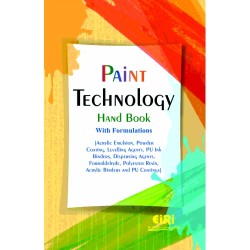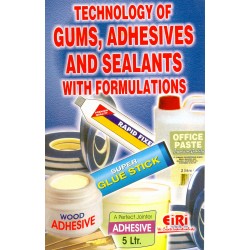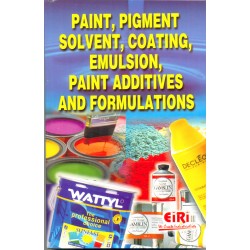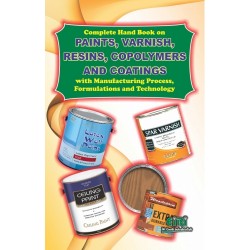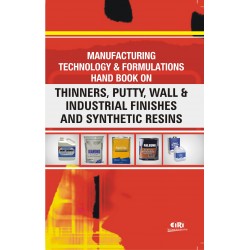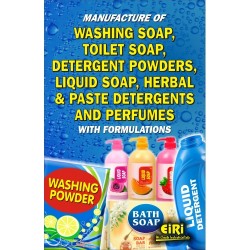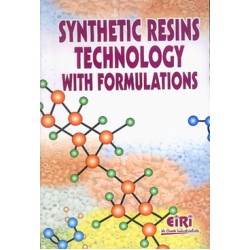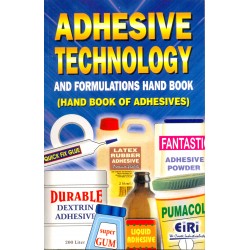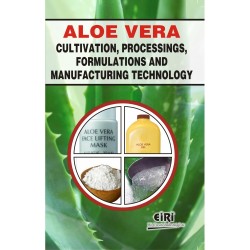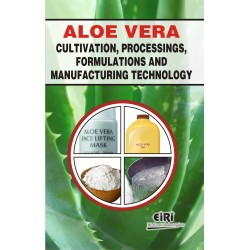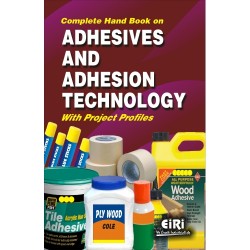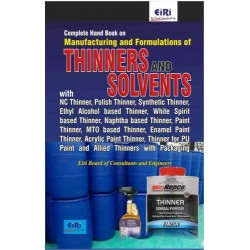technology of paints & coatings with formulations (hand book)
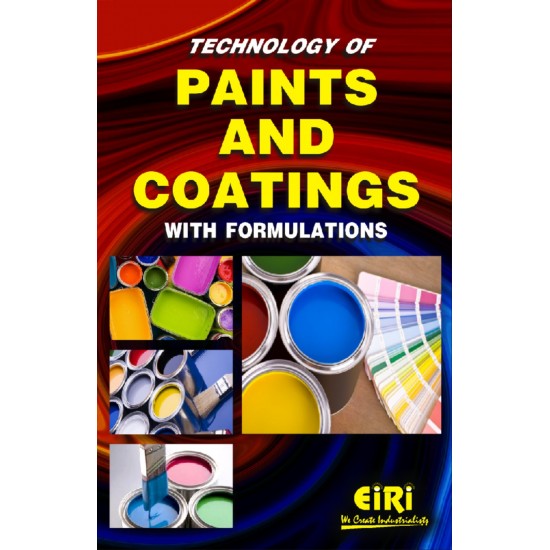
- More than 40 years of experience
- Managed by expert industrial consultants
- ISO 9001-2015 Certified
- Registered under MSME, UAM No: DL01E0012000
- 24/5 Research Support
Get your quesries resolved from an industry expert. Ask your queries before report or book purchase. - Custom Research Service
Speak to the our consultant to design an exclusive study to serve your research needs. - Quality Assurance
All reports are prepared by highly qualified consultants & verified by a panel of experts. - Information Security
Your personal & confidential information is safe & secure.
The book Technology of Paints & Coatings with Formulations covers Resins (Water Borne) for Coatings, High Solids Green Coatings (Air Drying), Technology of Primer Compositions (Alkyd Resins), Acrylic Polyols Technology, Biodegradable Surface Coatings, Binders for Premium Paints, Cyclized Rubber in Surface Coatings, Coatings for Medical Application, Dacro Coating, Epoxy Resin, Extraction, Modification and Applications of CNSL/Cardanol Based Epoxy Resin, Elastomeric Poly urea coatings, Formulation of 2K Waterborne Concrete Floor Coatings, Green Coating, Herbal Coating, High Temperature Coatings Technology, Infrared Spectroscopy: Its Relevance in the Field of Surface Coating,Marine Paints & Coatings, Magnetic Paint, Nanotechnology, PU Coatings, Photo Luminescent Paints, Polyaspartics, Phenolic Resins, Paints based on Agricultural Materials, Polyester Powder Coatings, Paint Coating on Galvanized Steel in Coil Coating Line, Photocatalytic Coatings,Ketonic Resins, Radiation Cure Coat.
Contents
Resins (Water Borne) for Coatings
Epoxy Resins
Acrylic Resins
Alkyd Resins
Polyester Resins
Polyurethane Resins
Anionic
Cat ionic
Non-Ionic
Acetone process (Solution process)
Pre-polymer mixing process
Hot melt process (Solvent free method)
Ketamine or Ketazine
Self dispersing of solids
Blocked isocyanates
crosslinking with melamine formaldehyde resins
Zirconium compounds
High Solids Green Coatings (Air Drying)
Introduction
Experimental
Materials
Synthesis of Resins
Preparation of dry films
Characterization methods
Results & Discussion
Physical Properties
Rheological Characteristics
Molecular Weight Characteristics
VOC characteristics
Drying properties
FT- IR Study
Differential Scanning Calorimeter (DSC) study
Thermal properties
Mechanical properties
Optical properties
Atomic Force Microscopic (AFM) imaging
Chemical resistance and Durability
Conclusions
Technology of Primer Compositions (Alkyd Resins)
Introduction
Experimental
Synthesis of alkyd resin
Synthesis of alkyd emulsion
Stability of emulsion10
Synthesis of wood primers and cement primers
Results and discussions
Acrylic Polyols Technology
Introduction
Basic chemistry
Synthesis of acrylic polyols
Properties of acrylic polyols
Applications of acrylic polyols
Synthesis of acrylic-polyurethane hybrid coatings
Modified acrylic polyols
Dual UV/thermal cure systems
Bio-acrylic polyols
OEM coatings based on Acrylic Polyols
Wood coatings
Industrial Coatings
Two component polyurethane coatings
Automotive refinishing coating
Biodegradable Surface Coatings
Introduction
Biodegradable coatings
Necessity of biodegradation
Life cycle of biodegradable coating
Classification of biodegradable coatings
Natural biodegradable coatings
Synthetic biodegradable coatings
Synthesis of biodegradable coatings Oils
Lallemantia Iberica
Eurphorbia Legascae (Vernonia oil)
Lesquerella oil
Oiticica oil
Sucrose and insulin
Lignin
Cellulose
Starch
Isocyanates
Additives
Plasticizer
Rheology modifier
Biosurfactants
Polyhydroxyalkalonoates
Polyesteramides
Interpenetrating polymers from oils
Polysaccharide resins
Natural resins
Application of biodegradable coatings
Future of biodegradable coatings
Binders for Premium Paints
Introduction
Why low odor?
Experimental
Testing of premium interior brands in India
Formulating low VOC low odor paint
Results and Discussions: Odor and VOC
Paint Properties
Scrub Resistance
Stain Resistance
Burnish resistance
MTO Resistance
Conclusion
Cyclized Rubber in Surface Coatings
Structure
Properties
Typical properties
Physical data
Technical benefits of cyclized rubber
Solvents and compatibility
Compatibility
Compatibility with drying oils
Compatibility with resins
Compatibility with plasticizers
Specific gravity
Solubility and solvent mixtures
Chemical resistance
Water resistance
Corrosion resistance
Adhesion
Flexibility and impact resistance
Paint application
Application Areas
Coatings for Medical Application
Introduction
Medical coating characteristics
Medical coating classification
Application Methods
Polymers for medical application
Polyglycolide (PGA)
Polylactide (PLA)
Poly (E-caprolactone)
Poly(dioxanone) (a polyetherester)
Poly(lactide-co-glycolide)
Poly(glyconate)
Parylene
Degradation
Factors That Accelerate Polymer Degradation
Specialised medical coatings
Drug-Eluting Stents
Application of stent coating
DES Basics
Tablet Coatings
Pigments
Polishing
Conclusion
Dacro Coating
Dacro Structure
Dacro Process
Dacro Advantage
Dacro Analysis
Dacro Scope
Dacro Coating in India
Epoxy Resin
Introduction
Structure
Epoxy resin coating
Hybridisation
The method of curing
Modification of resin
Mixture of resins
Blending
Alloying
Inter Penetrating Networks
Sol-Gel method
Emulsion polymerization & Dispersion polymerization
Curing of hybrid epoxy polymers
Characterization of hybrid resins
Hybrid polymers of epoxy resin used in coating application
Epoxy esters
Epoxy acrylics
Epoxy silicones
Epoxy urethanes
Conclusion and future directions
Extraction, Modification and Applications of CNSL/Cardanol Based Epoxy Resin
Introduction
Extraction of CNSL
Studies on the cardanol based novolac resins
Studies on the epoxidized novolac resins derived from CNSL or cardanol
Studies on the modification of CNSL or cardanol
Applications of CNSI7 Cardanol derived products
Elastomeric poly urea coatings
Introduction
Chemistry
Raw materials
Application of polyurea coatings
Typical properties of polyurea coatings
Application areas of olyurea coatings
Advantages of polyurea systems
Disadvantages of polyurea systems
Formulation of 2K Waterborne Concrete Floor Coatings
Introduction
Experimental
Materials and Formulations
Preparation of Drawdowns & Concrete Panels
Performance Testing
Gloss Measurement
Adhesion testing
Chemical resistance testing
Hot Tire resistance testing
Results & Discussions
Comparing liquid epoxy resins Epoxy X with Epoxy W
Pot-life evaluation based on gloss and adhesion
Chemical and solvent resistance testing
Hot Tire resistance
Green Coating
Need for green
What is green?
Rules and regulations
VOC Definition in the US, EU & UK
United States Definition
European Union definition
UK Coating Classification
Regulationsforlead in India
Regulations for lead in Europe
Regulationsfor lead in Australia
Regulationsforlead in US
Pollution from paints
Solvents
Pigments
Additives
Environmental impacts and risks
Research and developments in order to get greener coatings
Low voc emulsion polymer coating
Low volatile ethylene glycol derivatives
Fluorosurfactant
Green solvent
Emerging technologies
Advantages of VIC
Ecofriendly waste disposal technique
It’s not easy being green
Herbal Coating
Introductions
Turmeric in Herbal Paints
Chemistry of turmeric
Oleic acid
Experimental
Materials and Methods
Method of Extraction
Evaluation of Turmeric resin extract
Analysis of oleic Acid modified Turmeric Resin
Results and discussion
Analysis of Raw Material
Extraction of resin from turmeric
Analysis of turmeric Resin
Evaluation of the Film properties of Turmeric Resin
Modification of the termeric Resin with Oleic acid
Physical Properties
Film Properties
Composition
From the results
High Temperature Coatings Technology
Introduction
Experimental
Composition of titanium oleate
Preparation of titanium oleate
Evaluation of titanium oleate
Composition and evaluation of aluminium paint
Heat resistance of aluminium paint
Determination of weight loss at different temperatures
Results and discussion
Infrared Spectroscopy : Its Relevance in the Field of Surface Coating
Introduction
Sampling
Amount
Preparation
Analysis time
Epoxy
Alkyd
Marine Paints & Coatings
Introduction
Key Performance requirements
Experimental
Material used
Evaluation of film characteristic
Testing method and evaluation
Pot life
Drying time
Cross Hatch Adhesion Testing
Gloss Value
Erichsen Cupping Test
Research significance
Experimental investigation
Result Analysis and Discussion
Magnetic Paint
Introduction
Preparation of Magnetic paint
Ingredients to be used for formulation
Application Technology
Primer Layer
Back Coat Layer
Coating composition having magnetic properties
Areas of application
Application tips and suggested uses
Painting on textured walls
Mounting posters magnetically
Wall Decorations
Magnetic words and poetry
Nanotechnoloogy
Introduction to Nanotechnology
What is nanotechnology?
Nanoscience Vs Nanotechnology
Dimensional classification of nanoscale
Nanoscale in One Dimension
Nanoscale in Two Dimensions
Carbon Nanotubes
Inorganic Nanotubes
Nanowires
Biopolymers
Nanoscale in Three Dimensions
Nanoparticles
Fullerenes (carbon 60)
Dendrimers
Quantum Dots
Technology
Synthesis and Assembly of Nanomaterials
UV- curable coatings
Anti-abrasion and anti-scratch coatings
Anti-corrosion coatings
Self-healing nanotechnology antic orrosion coatings as alternative to toxic chromium
Super-hydrophobic coatings
Barrier coatings
Oxylink Technology
Matte coatings
Self cleaning technology
Making use of hydrophobic and oil repellent property of nanoparticles
Nanoparticles in high performance coating
Anti-fouling coating
Nanotechnology roof coating
The risk factor
Health Issues
Environmental issues
Future of nanotechnology
PU Coatings
Introduction
Experimental
Materials
Preparation of polyol
Characteristics of epoxy polyol (EP)
Characteristics of HDI
Chemical compositions
Results and discussion
FT IR Spectral analysis
FT IR spectra of epoxy polyol
FT IR Spectra for polymer
FT IR Spectra for polymer-H
Photo Luminescent Paints
Introduction
Mechanism of action
Effect of temperature on the afterglow
Manufacturing of the pigment
With Polyurethane Resins
With Epoxy Resins
Applications
Comparison between fluorescent and photo luminescent paints and alternative energy sources
Polyaspartics
Introduction
What are Polyaspartic Esters?
Chemistry
Reaction of aspartic acid ester with isocyanate
Polyurethane/Polyurea/Polyaspartks What’s the Difference?
Reactivity
Applications
Limitation
Phenolic Resins
Introduction
Experimental
Materials
Synthesis of phenol-cardanolformaldehyde novolac type phenolic resins
Epoxidation of phenol-cardanolformaldehyde novolac type phenolic resin
Characterization
Fourier-transform Infrared (FT-IR) spectroscopic analysis
‘H-NMR
spectroscopic analysis
Gel permeation chromatographic (GPC) technique
Differential Scanning Calorimetry (DSC)
Results and Discussion
Synthesis of phenol-cardanolformaldehyde novolac type phenolic resins
FT-IR spectroscopic analysis
1H-NMR spectroscopic analysis
Epoxidation of novolac prepolymer
Differential Scanning Calorimetric (DSC) analysis
Paints based on Agricultural Materials
Introduction
Soybean
Soybean oil-based waterborne polyurethane system
Soybean oil-based polyols
Soybean oil-based wetting and dispersing agents
Lignin
Lignin based paints
Corn
Corn based paints
Xanthum Gum
Starch
Sugar based polymers
Solvents
Monomers
Coalescents
Polyester Powder Coatings
Introduction
Using bi-functional hardener
Co-extrusion of resins
Polyester Dead Matt
Using reactive matting agent
Paint Coating on Galvanized Steel in Coil Coating line
Introduction
Preparing of substrate for paint coating
Alkaline solution cleaning
Conversion coatings
Test conducted to study the performance of the coated product
Impact test
Bending adhesion test
Flexibility test
Hardness test (Pencil test)
Chemical resistance test
Salt spray test
Heat resistance test
MEK (Methyl ethyl ketone) test
Coating characteristics
Factors affecting the performance of paint coating
Effect of tensions at various sections
Effect of alkali and conversion coating bath concentration
Bending adhesion test
Salt spray test
Hydrogen Evolution (Crater)
Effect of peak metal temperature in primer oven and top coat oven
Bending adhesion test
Hardness test
Impact test
MEK (Methyl ethyl ketone) test
Uses of coatings
Conclusions
Photocatalytic Coatings
Introduction
Materials
Titanium dioxide
Silicone resin
Experimental
Methylene blue test
Cigarette smoke test
Outdoor-exposure
Results
Comparison of titanium dioxide
Binder
Interior paints
Exterior paints
Conclusion
Ketonic Resins
Introduction
Aim of the present investigation
Experimental
Composition of ketonic resin
Preparation of ketonic resin
Evaluation
Effect of heat on softening point
Effect of plasticization on film properties
Effect of stoving on film properties
Results and discussion
Radiation Cure Coatings
Introduction
Curing mechanism
Raw materials for radiation cure coatings
Oligomers
Epoxy acrylates
Urethane acrylate
Polyester acrylates
Polyether acrylates
Amine modified polyether acrylates
Acrylic acrylates
Miscellaneous oligomers
Monomers
Photo initiators
Additives
Pigments
Cation curing
Powder coatings
Application areas of radiation cure coatings
Advantages and disadvantages of radiation cure coatings
Advantages
Disadvantages
Self-Healing - Coatings
Introduction
Approaches
Liquid phase healing agent
Microcapsulation
Phase separated healing agent
Hollow tubes or fibers
Three-dimensional micro vascular network
Solvent- promoted self-healing
Nanoparticles segregation
Solid phase (Heat activated)
Thermally rcmendable
Thermoplastic/thermoset blend
Cyclic oligomers
Projectile puncture
Other approaches
Quantifying healing effectiveness
Potential Application of Self healing
Stealth Coatings for Aircraft and ships
Detection techniques for an aircraft
Measuring stealth
Importance of Coatings in Stealth Technology
Additional expectations from Stealth coatings
Types of Coatings used in Stealth Technology
A. Iron Ball Paint
Carbonyl Iron
Silver-coated Cenosphere
Typical Physical Parameters of Cenospheres
Ferro fluids and non-magnetic substances
Strontium 90
Neoprene
Coatings based on Gold and Indium
Radar stealth countermeasures and limitations
Low frequency radar
IR Stealth
Stealth Coatings in Drugs
Stealth Coatings in Foods
Probable Abuses of Stealth Coatings
Futuristic Coatings
Combined Infrared and Radar Stealth
Sol Gel Coatings
Introduction
Types of Solgels
Coating process and coating equipments
Spin coating
Dip coating
Roll /gravure coating
Typical examples of uses of Sol gel coatings
Monocyclic aromatic hydrocarbon sensors
Sampling of benzene and toluene
Carbon dioxide sensor
Sol gel & nano technology
Photonic solutions and sol gel
Sol gel integrated optics
Optical Gain materials
Non linear materials
Elastomeric reinforcement strategies
Topochemistry of wood -inorganic composites
Vacuum Metallizing Coating on Plastic Automotive Components
Introduction
Vacuum Metallizing Coating on plastic components
Requirement of substrate material
Pretreatment of substrate surface
Post-Treatment
Equipment
Plastic Packaging for Paints
Introduction
Basic requirements for paint packaging
Conventional packing materials
Advantages and disadvantages of conventional packing materials
Selection of the packing materials
New generation packing materials
Water soluble plastics for packaging of water based paints
Introduction
Application for the paint Industry
Properties of water soluble plastics
Water Solubility
Sealing properties
Oil and chemical resistance
Strength and weathering resistance
Biodegradable properties
Moisture content
Static electricity/surface resistivity
Moisture permeability and Gas resistance
Advantages of water soluble plastics
Disadvantages of water soluble plastics
Different types of packaging
Polymer coated steel
Introduction
Polymer coated steel and its performance with solvents (Table 1)
Application and benefits of polymer coated steel (Table 2)
Advantages of polymer coated steel
Silicone Resin Paints
Introduction
Silicons Resin Emulsion Paints
SREP Technology
Silicone Resin Chemistry
A functional network is created in the construction material
SREP Properties
Functional facade protection retains a building’s value
Excellent protection against wetness
Dry facades prevent algae
Facades that can breathe
Long-lasting facade protection saves renovation costs
Weathering resistance
Facades keep their color
A permanently attractive facade
Simple & Fast Processing
Easy to over paint
Fast and efficient
Solvent free & ecologically more sound
Extremely stable and nonchalking
Test methods: Certified quality
How to Make Project Report?
Detailed Project Report (DPR) includes Present Market Position and Expected Future Demand, Technology, Manufacturing Process, Investment Opportunity, Plant Economics and Project Financials. comprehensive analysis from industry covering detailed reporting and evaluates the position of the industry by providing insights to the SWOT analysis of the industry.
Each report include Plant Capacity, requirement of Land & Building, Plant & Machinery, Flow Sheet Diagram, Raw Materials detail with suppliers list, Total Capital Investment along with detailed calculation on Rate of Return, Break-Even Analysis and Profitability Analysis. The report also provides a birds eye view of the global industry with details on projected market size and then progresses to evaluate the industry in detail.
We can prepare detailed project report on any industry as per your requirement.
We can also modify the project capacity and project cost as per your requirement. If you are planning to start a business, contact us today.
Detailed Project Report (DPR) gives you access to decisive data such as:
- Market growth drivers
- Factors limiting market growth
- Current market trends
- Market structure
- Key highlights
Overview of key market forces propelling and restraining market growth:
- Up-to-date analyses of market trends and technological improvements
- Pin-point analyses of market competition dynamics to offer you a competitive edge major competitors
- An array of graphics, BEP analysis of major industry segments
- Detailed analyses of industry trends
- A well-defined technological growth with an impact-analysis
- A clear understanding of the competitive landscape and key product segments
Need Customized Project Report?
- Ask for FREE project related details with our consultant/industry expert.
- Share your specific research requirements for customized project report.
- Request for due diligence and consumer centric studies.
- Still haven't found what you're looking for? Speak to our Custom Research Team
About Engineers India Research Institute:
Our Approach
- Our research reports comprehensively cover Indian markets (can be modified as per your country), present investigation, standpoint and gauge for a time of five years*.
- The market conjectures are produced on the premise of optional research and are cross-accepted through associations with the business players
- We use dependable wellsprings of data and databases. What's more, data from such sources is handled by us and incorporated into the report
Why buy EIRI reports?
- Our project reports include detailed analysis that help to get industry Present Market Position and Expected Future Demand.
- Offer real analysis driving variables for the business and most recent business sector patterns in the business
- This report comprehends the present status of the business by clarifying a complete SWOT examination and investigation of the interest supply circumstance
- Report gives investigation and top to bottom money related correlation of real players/competitors
- The report gives gauges of key parameters which foresees the business execution





















